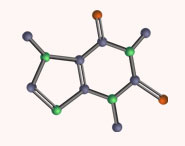


 علم الكيمياء
علم الكيمياء 
 الكيمياء التحليلية
الكيمياء التحليلية 
 الكيمياء الحياتية
الكيمياء الحياتية 
 الكيمياء العضوية
الكيمياء العضوية 
 الكيمياء الفيزيائية
الكيمياء الفيزيائية
 الكيمياء اللاعضوية
الكيمياء اللاعضوية 
 مواضيع اخرى في الكيمياء
مواضيع اخرى في الكيمياء
 الكيمياء الصناعية
الكيمياء الصناعية | Hemiacetals from reaction of alcohols with aldehydes and ketones |
|
|
|
أقرأ أيضاً
التاريخ: 2025-04-29
التاريخ: 19-2-2017
التاريخ: 12-7-2018
التاريخ: 2025-01-14
|
Since water adds to (at least some) carbonyl compounds, it should come as no surprise that alcohols do too. The product of the reaction is known as a hemiacetal, because it is halfway to an acetal, a functional group that you met in Chapter 2 (p. 32) and that will be discussed in detail in Chapter 11. The mechanism follows in the footsteps of hydrate formation: just use ROH instead of HOH.
In the mechanism above, as in the mechanism of hydrate formation on p. 134, a proton has to be transferred between one oxygen atom and the other. We have shown a molecule of ethanol (or water) doing this, but it is impossible to defi ne exactly the path taken by any one pro ton as it transfers between the oxygen atoms. It might not even be the same proton: another possible mechanism is shown below on the left, where a molecule of ethanol simultaneously gives away one proton and takes another. In the simplest case, the proton just hops from one oxygen to another, as shown in the right, and there is no shame in writing this mechanism: it is no more or less correct than the others.
What is certain is that proton transfers between oxygen atoms are very fast and are reversible, and for that reason we don’t need to be concerned with the details—the proton can always get to where it needs to be for the next step of the mechanism. As with all these carbonyl group reactions, what is really important is the addition step, not what happens to the protons. Hemiacetal formation is reversible, and hemiacetals are stabilized by the same special structural features as those of hydrates. However, hemiacetals can also gain stability by being cyclic—when the carbonyl group and the attacking hydroxyl group are part of the same molecule. The reaction is now an intramolecular (within the same molecule) addition, as opposed to the intermolecular (between two molecules) ones we have considered so far.
Although the cyclic hemiacetal (also called lactol) product is more stable, it is still in equilibrium with some of the open-chain hydroxy aldehyde form. Its stability, and how easily it
forms, depends on the size of the ring: five- and six-membered rings are free from strain (their bonds are free to adopt 109° or 120° angles—compare the three-membered rings on p. 135), and five- or six-membered hemiacetals are common. Among the most important examples are many sugars. Glucose, for example, is a hydroxy aldehyde that exists mainly as a six-membered cyclic hemiacetal (>99% of glucose is cyclic in solution), while ribose exists as a five-mem bered cyclic hemiacetal.



|
|
|
|
حقن الذهب في العين.. تقنية جديدة للحفاظ على البصر ؟!
|
|
|
|
|
|
|
علي بابا تطلق نماذج "Qwen" الجديدة في أحدث اختراق صيني لمجال الذكاء الاصطناعي مفتوح المصدر
|
|
|
|
|
|
|
ضمن برنامج تأهيل المنتسبين الجدد قسم الشؤون الدينية يقدم محاضرات فقهية وعقائدية لنحو 130 منتسبًا
|
|
|